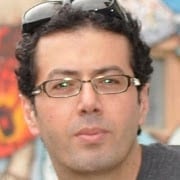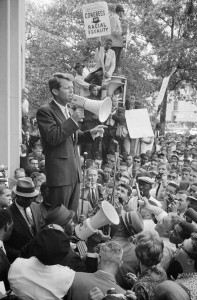Non-violent BDS Should Be Welcomed, Not Condemned
![]() Ramzy Baroud, PhD
Ramzy Baroud, PhD
Truth’s Advocate
![]() [dropcap]A [/dropcap]thousand Israelis and their supporters gathered in Jerusalem’s International Convention Center on March 28 at a conference aimed at combating the Boycott, Divestment and Sanctions movement (BDS).
[dropcap]A [/dropcap]thousand Israelis and their supporters gathered in Jerusalem’s International Convention Center on March 28 at a conference aimed at combating the Boycott, Divestment and Sanctions movement (BDS).
The conference was a display of “fear, paranoia, anger and determination,” as described by Antony Loewenstein, and featured top government officials, members of the oppositions and a strange conglomerate of guests, including celebrity has-beens like Roseanne Barr.
Statements made at the conference were predictably frightening and antagonistic – they amounted to nothing more than a display of the language of blood and vengeance that people have grown accustomed to within the Israeli political discourse.
One of the most alarming of the statements was made by Israeli Minister of Transportation, Israel Katz, who called for the “focused civilian elimination of the leadership of BDS.”
We need to know how “to act against them, how to isolate them, also to transfer information to intelligence agents around the world, and other agents. We have to understand that there is a battle here. It is wrapped in many covers,” Katz said.
Barr on the other hand, called for nuclear bombing the University of California-Davis following its students’ support of BDS.
One must certainly have no illusions regarding the ferocity of the fight ahead – this is the nature of conflict between any popular movement, the objective of which is to put pressure on a state that violates international law with impunity, and a government that sees itself above and in no way bound by the law.
The impetus behind the antagonism faced by the BDS movement is that it has in fact matured in its message and grown in size with its primary objective clear-cut – Israel, sooner or later would see BDS as a threat, and would move decisively to combat it.
However, one can certainly not be oblivious to the internal challenges faced by BDS itself. While the movement is largely de-centralized, and local decisions are left to the numerous branches located throughout the world, speaking in one voice is a certain challenge. Of course, there are the guiding principles, but it remains essential to overcome the practical hindrances to an honest and transparent democratic dialogue in order to keep the movement strong and forward thinking.
BDS was initiated after repeated calls from Palestinian civil society, especially in 2004 and 2005 to boycott Israel for its crimes against Palestinians, its violations of international law, its illegal occupation and its discriminatory, racially-motivated policies. The call found receptive audiences across the world, and over the last decade it became the primary platform, if not rally-cry for pro-Palestine activists confronting Israel.
BDS did not expand so significantly in recent years only because of its own organization and successful branding. One cannot ignore the multiple crimes carried out by the Israeli army and armed Jewish settlers since then. One cannot overlook the many racist laws passed by the Israeli Knesset, targeting the country’s minorities. With every killing, every additional day of siege on Gaza, every war, and every abhorrent statement made by an Israeli official, BDS grew – significantly.
BDS owes much of its success to an effective strategy that is predicated on harnessing the energy of civil society, but also to the fact that Israel is relentless in demonstrating the need for global action, to end the occupation, the discrimination and the impunity of an army that killed much too many Palestinians.
Yet, not until recently did Israelis and their supporters begin viewing BDS with alarm, if not real concern. In the past, that job was left to Zionist student groupings in Western campuses. But they failed, and terribly so, to stem the flow of the pro-Palestine sentiments in US-Western campuses. As of last year, a large anti-BDS movement began forming with the sole purpose of crushing the budding BDS movement, but to no avail.
The ‘big guns’ were summoned by two massively rich Zionists, casino mogul Sheldon Adelson and Haim Saban. They invited fellow millionaires to a June 2015 conference in Las Vegas in order to raise funds for an anti-BDS movement. Those invited, mostly rightwing zealots, went to the Venetian hotel, (also owned by Adelson) wiih the understanding that a minimal acceptable donation is one million dollars.
Anti-BDS activists and government officials who travelled to Las Vegas for the event were promised by an Israeli-American businessmen, Adam Milstein that they “no longer have to worry about financing and fundraising. You just need to be united.”
Galvanizing on the momentum, Hillary Clinton, who is now leading in her party’s primaries as a precursor for presidential elections in November, sent Saban a letter that could serve as a glaring example of a politician groveling to a rich funder with no regard for morality or self-respect:
Under the letter heading, ‘Hilary for America,’ she wrote to “express her alarm” over BDS, insisting that countering the movement must become a ‘priority’. “I am seeking your advice on how we can work together to reverse this trend,” she wrote.
“As a Senator and a Secretary of State, I saw how crucial it is for America to defend Israel at every turn. I have opposed dozens of anti-Israel resolutions at the UN, the Human Rights Council and other international organizations,” she boasted, going as far as condemning the Goldstone Report which accused Israel of committing war crimes in Gaza.
Clinton is not alone. In June 2015, soon after the anti-BDS millionaires’ club concluded its gathering in Las Vegas, President Barack Obama signed into law a measure specifically designed to combat BDS.
“The Trade Promotion Authority legislation .. contained the anti-BDS provisions, which make rejection of the phenomenon a top priority for US negotiators as they work on a more distant free trade agreement with the European Union,” the Times of Israel reported.
Within months, the flood-gates had opened, and a foray of BDS condemnations followed. Yet, this was largely a farce. The calls from Western governments, originating from the UK, the US, Canada and others to criminalize the boycott of Israel have hardly slowed down the momentum of the movement. On the contrary, it has accelerated it.
History has taught us that criminalizing civil society and outlawing ideas, especially those that are guided by moral principles, is never a good idea. Nor is calling for ‘eliminating’ civilian society activists and bombing their universities.
The only sensible strategy to combat BDS is one that not a single speaker in the anti-BDS gatherings had raised: ending the very criminal and racist policies that inspired BDS in the first place.
BDS has, thus far, been the most successful strategy and tactic to support Palestinian steadfastness while, at the same time, holding Israel accountable for its progressively worsening policies of apartheid.
International pressure is building up, placing the ball firmly in the Israeli court, and no amount of bombs or firepower can ever solve Israel’s quandary this time.
![]()
 Has been writing about the Middle East for over 20 years. He is an internationally-syndicated columnist, a media consultant, an author of several books and the founder of PalestineChronicle.com. His books include ‘Searching Jenin’, ‘The Second Palestinian Intifada’ and his latest ‘My Father Was a Freedom Fighter: Gaza’s Untold Story’. His website is: www.ramzybaroud.net.
Has been writing about the Middle East for over 20 years. He is an internationally-syndicated columnist, a media consultant, an author of several books and the founder of PalestineChronicle.com. His books include ‘Searching Jenin’, ‘The Second Palestinian Intifada’ and his latest ‘My Father Was a Freedom Fighter: Gaza’s Untold Story’. His website is: www.ramzybaroud.net.
=SUBSCRIBE TODAY! NOTHING TO LOSE, EVERYTHING TO GAIN.=
free • safe • invaluable
[email-subscribers namefield=”YES” desc=”” group=”Public”]




